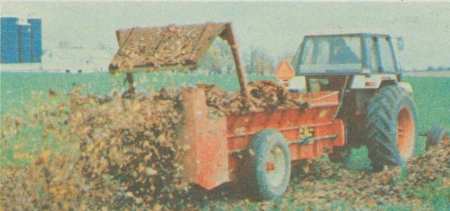
Getting rid of leaves is a major problem for towns and cities each fall especially since space in sanitary landfills is becoming more and more limited. University of Wisconsin soil scientist Arthur Peterson is working with both cities and farmers to try to turn leaves into an asset by spreading them on farmland.
Many communities have started composting leaves but Peterson says composting is too labor intensive and not necessary. He'd like to go as directly as possible from city yards to fields. For the past several years he's been spreading leaves on test plots, looking for the best tillage method to incorporate them for the fastest breakdown. Last fall, he supervised distribution of more than 80 tons of leaves on a 4-acre corn field near Madison.
The biggest challenge faced was how to spread leaves evenly across the field. "We tried a front-end loader first, but we couldn't get an even spread. Then we tried a side-unloading spreader but that was too slow. We finally found that a conventional rear-unload manure spreader with beaters does the best job," says Peterson.
Once the leaves are spread, the next problem is incorporating them into the soil. He tried chisel plows, offset disks and other tools but found that a rotary tiller does the best job. "Offset disks just rolled right over them but tillers break them up and work them down under ground."
The problem with tillers is that it takes a long time to till a big field. So Peterson has started chopping the leaves in a tub grinder and spreading the chopped-up pieces. "Once they're chopped, a disk can turn them under," he notes, adding that it costs cities a lot of money per ton to dispose of leaves in sanitary landfills. For that price, they could purchase tub grinder and truck spreaders and spread the leaves on local farmland."
Peterson says there are about 250 lbs. of nitrogen per acre in leaves when applied at a rate of 20 tons per acre. He's had good yields in test plots and notes that the increased organic mater greatly increases water absorption capacity of fields.
